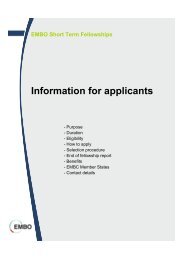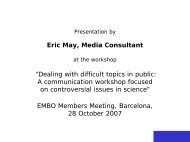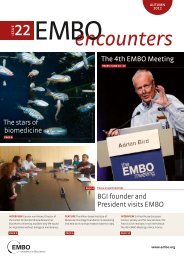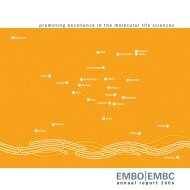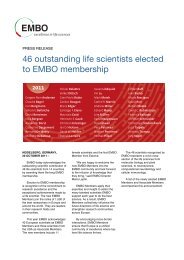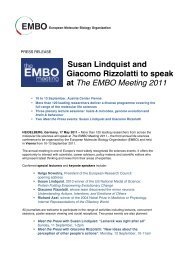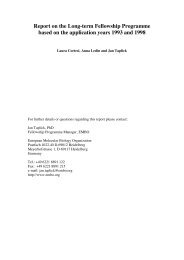EMBO Fellows Meeting 2012
EMBO Fellows Meeting 2012
EMBO Fellows Meeting 2012
You also want an ePaper? Increase the reach of your titles
YUMPU automatically turns print PDFs into web optimized ePapers that Google loves.
John Burke<br />
<strong>EMBO</strong> <strong>Fellows</strong> <strong>Meeting</strong> <strong>2012</strong><br />
Deuterium exchange mass spectrometry used to probe membrane recruitment of<br />
the common oncogene phosphoinositide 3-kinase (p110α)<br />
Abstract<br />
Most cellular responses to extracellular stimuli have a common component of regulation arising from selective<br />
recruitment of a network of signalling complexes to membranes. However, studying these systems remains a<br />
daunting task. We have made unprecedented progress in understanding these systems by applying a<br />
synthesis of deuterium exchange mass spectrometry (DXMS), X-ray crystallography and FRET spectroscopy<br />
towards the PI3 kinase (PI3K) family of proteins. PI3Ks are lipid kinases that are involved in a variety of cellular<br />
functions, including growth, proliferation, and metabolism. The importance of regulating PI3K activity is<br />
highlighted by the fact that the PI3K p110α catalytic subunit (PIK3CA) is one of the most frequently mutated<br />
genes in cancer.<br />
Using DXMS we have examined the activation of wild-type p110α/p85α and a spectrum of oncogenic mutants<br />
in three enzyme states: basal, RTK phosphopeptide activated, and membrane bound. Differences in amide<br />
exchange rates upon activation show that for wild-type p110α/p85α the transition from an inactive cytosolic<br />
conformation to an activated form on membranes entails four distinct conformational events. DXMS results for<br />
cancer mutants show that all upregulate the enzyme by enhancing one or more of these dynamic events.<br />
Protein-lipid FRET and lipid kinase assays showed that all mutations increased binding to membranes and<br />
basal lipid kinase activity, even mutations distant from the membrane surface. Our results elucidate a unifying<br />
mechanism in which diverse PIK3CA mutations stimulate lipid kinase activity by facilitating motions required for<br />
catalysis on membranes.<br />
John E. Burke, Olga Perisic, Glenn Masson, Oscar Vadas, and Roger L Williams<br />
MRC Laboratory of Molecular Biology, Cambridge UK<br />
14-17 June <strong>2012</strong>, Heidelberg, Germany




